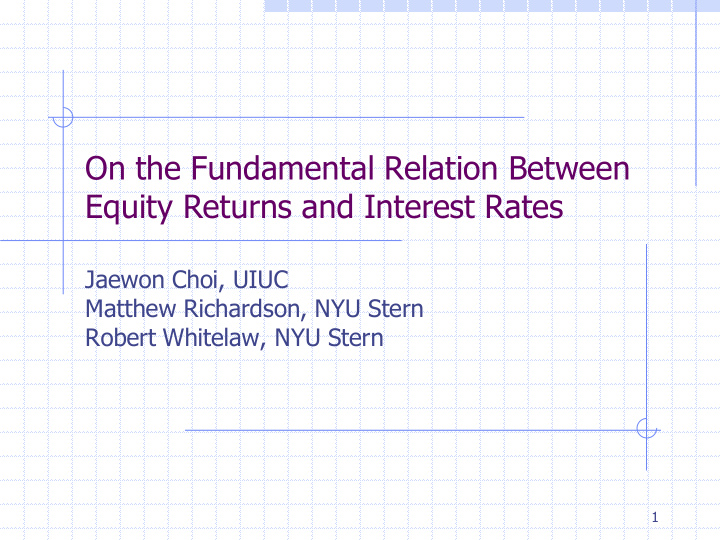



On the Fundamental Relation Between Equity Returns and Interest Rates Jaewon Choi, UIUC Matthew Richardson, NYU Stern Robert Whitelaw, NYU Stern 1
The Impact of Interest Rates Financial Claims Real Assets Bank debt Senior bonds Inventory PP&E Growth options Junior bonds Equity Two effects: 1. Δ interest rates Δ asset value Δ debt, Δ equity 2. Δ interest rates Δ debt, Δ equity
Rolling Correlations Correlations between returns and changes in interest rates are ordered by priority in the capital structure
Results Firms’ priority structure explains the relation between interest rates and corporate bond and equity returns Higher leverage, lower priority more negative duration Confirmed both at the firm and portfolio levels Capital structure effects are important for interpreting existing evidence Partially explains time-varying correlation between stocks and bonds Reveals potentially misleading decomposition into default and term premiums
Outline Theory based on capital structure priority Data and stylized facts Empirical evidence Reinterpreting existing empirical results
A Contingent Claims Approach Equity and debt are claims (options) on the underlying assets [Merton (1974), Rabinovitch (1989)] dV rV dt V dZ t t t V t t dr q m ( r d ) t v dW t t t dZ dW d t t t D K B ( , ) r P V K ( , , , , r ) s s s V D K B ( , ) r P V K ( , , , , r ) P V ( , K K , , , r ) j j s V s j V E V P V K ( , K , , , r ) ( K K ) ( B , ) r s j V s j
Duration D D V 1 Modified duration s V s Dur( D ) s V D v r D s s D D V 1 j j V Dur( ) D j V D v r D j j E V E 1 V D ur( E ) V E v r E Two effects: 1 2 1. An asset duration component 2. A capital structure component D D E j s V Dur( ) E Dur( D ) Dur( D ) Dur( ) V s j V V V v
Modified Duration: An Example Duration is more negative • for lower priority securities Leverage magnifies the • duration effect
Data Procedure Map out firm’s capital structure Construct returns for each security Compute asset returns as weighted average of security returns Summary statistics Coverage: 89.6% of debt structure (VW) Priority: ~30% with multiple priority bonds Maturity: ~6 years on avg Leverage: 0.75 avg and 0.32 median D/E (mkt values)
“Simple” Duration Estimates ò i R ( i ) t t t Leverage Senior Junior Equity Asset Zero -0.26 -0.26 1 3.18 2.45 -0.46 -0.17 2 3.04 2.62 0.04 0.51 3 2.79 2.41 0.04 0.83 High 2.22 1.81 0.29 0.87 Within leverage buckets, duration increases with priority • Asset duration increases with leverage •
Main Empirical Specification ( ) R i RA t 1 t t 1 t t 1 t 1 L P L P Z t 0 1 t 2 t 3 t t 4 t L P t 0 1 t 2 t R – Bond or equity returns τ – Time to maturity RA – Firm asset return L – Firm leverage, log(book debt/market value of assets) P – Bond priority, 0-1, 1 being the highest priority Z – Fixed effects for convertible, callable, floating rate, sinking fund, and asset-backed bonds
Results ( i ) P ( i ) L RA L ( i ) RA P RA Assets 0.55 0.16 Equity -0.63 -0.18 1.65 0.22 Bonds 0.27 -0.03 0.05 0.48 0.11 -0.14 1. Assets are positive duration, more so for levered firms 2. Equity is negative duration (once you control for asset effects), more negative as leverage increases 3. Bonds are positive duration, which a. Decreases with leverage b. Increases with priority
Portfolio Level Analysis R ( i ) t t t Senior Junior Equity AA 3.97 3.02 0.61 BBB 3.21 3.00 0.24 B 0.69 0.44 -3.52 1. Duration increases in priority 2. Duration increases in rating (decreases in leverage) 3. The differences are large between investment grade and high yield
Time-Varying Correlations between Equity and Debt High correlation between debt-equity return correlation and market level leverage: 0.63
Decomposing Returns into Term and Default Premiums The traditional approach: F LTG F Corp LTG R R ( R R ) ( R R ) t t 1 t t 1 t t t Term Default But the default factor does not isolate default risk. Corporate bonds’ duration can be very short if they are low priority claims default factor contains negative term premium In contrast, corporate minus “short - term” government bond isolates default risk.
Traditional Specification Misleading Corp LTG Corp 5 Yr Def1 Def2 R R R R t t t t AAA AA A BBB BB B Term 0.56 0.74 0.81 0.95 1.01 1.58 Def1 0.27 0.36 0.49 0.81 1.36 2.43 Term 0.39 0.52 0.52 0.47 0.21 0.15 Def2 0.04 0.05 0.21 0.50 1.03 1.99 Are AAA bonds really exposed to default risk? • Exposures to both term and default premiums are • exaggerated
Conclusion Capital structure matters! Equity is not assets Leverage and priority strongly influence interest rate sensitivity Security-specific effects also exist in portfolios/indices Time-varying debt-equity correlations Term and default premiums Corporate bond betas Return predictability Inflation and security returns
Recommend
More recommend